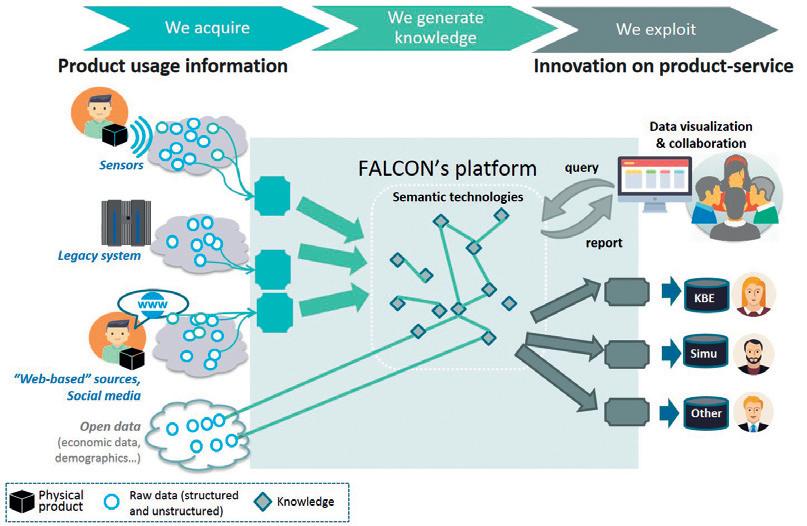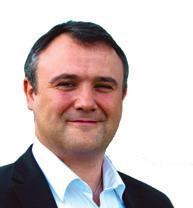Manufacturing intelligence to support innovative services

Many consumers today express their opinions about specific products and services via social media and other channels, while large volumes of information about how products are used are available from other sources as well. This data can offer valuable insights to the commercial sector, helping companies to improve the products and services they offer, a topic central to the work of the FALCON project. “We wanted to look at these sources of product-usage information. So this is information that is generated when a product is being used – from sensor systems for example. We also wanted to take into account social media and non-structured information that is generated by users on Facebook, internet forums and so on,” outlines Karl Hribernik, the project’s Technical Coordinator. “We investigated which of those product usage information channels could be used in product-service design, and for which type of product. How could we technically integrate that information into design and improvement processes?”
Product usage information
This is not just about improving the design of a product, but also the associated services around it. The value of a product is no longer determined purely at the manufacturing stage, but also through the provision of additional services that supplement the initial offering; the project’s work holds clear importance in these terms. “We try to provide tools to visualise, analyse and apply product usage information from different sources. We aim to help companies leverage that information in the services that they offer, beyond the actual products,” explains Hribernik. This research holds relevance to several different areas of industry; Hribernik says four business scenarios have been explored in the project, two of which are business-to-consumer sectors. “We have white and brown goods, such as washing machines, televisions and refrigerators, that are directly marketed to consumers. The second scenario in the business-to-consumer sector is clothing textiles,” he outlines.
The remaining two scenarios are businessto-business cases, where researchers looked at healthcare products and high-tech products. Different channels of product usage information are more important to specific sectors than others, an issue that Hribernik and his colleagues in the project investigated. “For example, there’s a lot of information about clothes on websites like Youtube, information which is valuable to the fashion industry. Social media is less valuable in the healthcare sector, as there is no valuable information out there on healthcare products. There are very good reasons for that,
misrepresented for example, while people in certain areas of the world may prefer a looser fit to those in other locations, something which researchers in the project took into account. “We effectively pre-process all the information, then make it available to the product designers on the platform, so that they can verify it. So they can ask; ‘ok, where did this information come from?’ ‘Who actually expressed this opinion about this product?’ ‘How old are they?’ And so on,” outlines Hribernik. In the other use cases, product usage information may be more structured. “For example, with sensors
in particular patient privacy,” he points out. A semantic model of the information relevant to each of the use cases has been developed, which lies at the core of the project’s platform. “For example, in the clothing use case there are product characteristics – you’ll find information on popular colours, sizes, and types of garments. Synonyms for these terms are also included in the model,” explains Hribernik.
A lot of information in this particular case is by nature unstructured and subjective, with individuals expressing their own views and opinions on clothing, while there may also be differences in interpretation. Colours may be

on a product you might get a temperature value, which is very structured information –you know exactly what it means, and you know exactly what component of a product it relates to,” says Hribernik.
This kind of information is relatively easy to interpret, while by contrast an Amazon review of a particular product would be significantly more complex. A user could use many different terms to express their opinion, and it may be difficult to understand whether the review relates to any specific component or function, so Hribernik says it’s necessary to look a little deeper. “We take that text apart, interpret it
Vast amounts of information are available today on how products and services are used, from which companies can draw valuable insights to improve design. Karl Hribernik tells us about the FALCON project’s work in developing a framework which will help to both improve product-service systems and shorten the development cycle
We try to provide tools to visualise, analyse and apply product usage information from different sources. We aim to help companies leverage that information in the services that they offer, beyond the actual productsFALCON Virtual Open Platform for product-service design and product lifecycle management
and extract information out of it, that we can then machine-process later,” he explains. The results of structured and unstructured data can be related to each other, from which it is easier to identify the root causes behind any problems with a product. “If your washing machine isn’t working that well, sensor values about how it’s been functioning can help identify the problem,” outlines Hribernik. “When we analyse the data, we can figure out that the washing machine hasn’t been cleaning very well because it hasn’t been used properly. Maybe the machine has been over-filled for example.”
Maintenance and support
Many commercial companies are keen to understand how their products are used, so this research holds broad relevance. With large volumes of data on how a specific product is being used, it could be possible to identify patterns across a larger sample size, and then assess whether further action is required. “If a certain proportion of people are putting too much washing into the machine then it might be necessary to either revise the manual or improve the design of the washing drum,” says Hribernik. In the case of the healthcare products, the FALCON tools can be used to identify which functionalities are used more often than others, insights which can then be applied to make systems easier to use. “We’re looking at how doctors use the user interface. Which buttons are they pressing? Do they press certain combinations more than others? Are there ways in which the user interface could be improved?” outlines Hribernik. “For example, if someone presses the same combination of five buttons ten times a day, maybe it would make sense to have one button for that function.”
The technology can be adapted in line with how people use it, rather than the other way round, with user feedback a significant influence on product development. The
project’s work could have a significant impact on the production process in general, helping to shorten the design phase of productservices. “By understanding what customers and users actually want faster and to a greater level of precision, it will be possible to meet their demands faster and more accurately. The effect could be to accelerate cycles of product and service innovation,” explains Hribernik. This is not limited to specific sectors, while it could also help smaller companies develop and build on their ideas faster. “We’ve not worked just with larger companies - we’ve also worked with smaller businesses, who are also able to use the FALCON system without the need to invest heavily in IT equipment. You can basically pull in social media and other data, and analyse it,” continues Hribernik. “So it’s good for very small companies, and it can be adapted to different sectors.”
There is also scope to include further information within the framework, something which Hribernik and his colleagues may explore in future. This could mean analysing image data from social media, giving further insights to product developers. “I think it would be quite interesting to investigate further in that direction, to include not only the semantic analysis of text, but also of images and other media available on the internet. So that’s another area we could branch out into,” says Hribernik.
FALCON
Feedback mechanisms Across the Lifecycle for Customer-driven Optimization of iNnovative product-service design
Project Objectives
FALCON aims to optimise the (re-)design of products and associated services by exploiting and processing product usage information. The FALCON virtual open platform will acquire and process usergenerated content from the Internet and data generated by sensors embedded into products, enabling a systematic and customer-driven (re)design of products, services and product-service systems.



Project Funding
RIA - Research and Innovation action

Project Partners
BIBA - Bremer Institut für Produktion und Logistik GmbH, Germany • EPFL - Ecole Polytechnique Federale de Lausanne, Switzerland • TU Delft - Technische Universiteit Delft, Netherlands • UBITECH - Gioumpitek Meleti Schediasmos Yloppiisi Kai Polisi Ergon Pliroforikis Etaireia Periorismenis Efthynis, Greece • Holonix SRL, Italy • Softeco Sismat SRL, Italy • I-Deal S.R.L.C.R., Italy • Arcelik A.S., Turkey • PHILIPS Medical Systems Nederland BV, Netherland • Dena Cashmere, Mandelli Laura, Italy • Datapixel SL, Spain • Mews Innovation, France • Isadeus, France
Contact Details
Karl Hribernik, Manager of the department of Intelligent ICT for Co-operative Production BIBA - Bremer Institut für Produktion und Logistik GmbH Hochschulring 20 28359 Bremen

T: +49 421 21850108
E: hri@biba.uni-bremen.de W: www.falcon-h2020.eu
• K. A. Hribernik, J. Lützenberger, E. Coscia, K.-D. Thoben, Feedback Mechanisms across the Lifecycle for Customer-driven Optimisation of Innovative ProductService Design, Proceedings of the I-ESA Conference 2016, 29 March-1 April 2016, Guimarães, Portugal.
Dipl.-Inform. Karl A. Hribernik
Dipl.-Inform. Karl A. Hribernik is manager of the department of Intelligent ICT for Co-operative Production at BIBA - Bremen Institute for Production and Logistics. He is the technical coordinator of FALCON and has been involved more than 15 years in many European projects related to Product Lifecycle Management.
